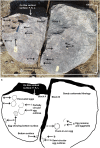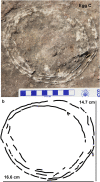First ovum-in-ovo pathological titanosaurid egg throws light on the reproductive biology of sauropod dinosaurs
- PMID: 35672433
- PMCID: PMC9174186
- DOI: 10.1038/s41598-022-13257-3
First ovum-in-ovo pathological titanosaurid egg throws light on the reproductive biology of sauropod dinosaurs
Abstract
Pathologic eggs have been documented in the amniote eggs of birds, turtles, and dinosaurs. These eggs occur either in the form of one egg within another egg, a condition known as ovum-in-ovo or multi-shelled eggs showing additional pathological eggshell layer/s besides the primary shell layer. Though multi-shelled eggs and eggshells were previously recorded only in reptiles and ovum-in-ovo eggs in birds, now it has been shown that multi-shelled egg pathology occurs in birds as well. However, no ovum-in-ovo egg has been reported in dinosaurs or for that matter in other reptiles. Here we describe an ovum-in-ovo pathological egg from a titanosaurid dinosaur nest from the Upper Cretaceous Lameta Formation of western Central India which makes it the first report of this pathology in dinosaurs. Birds possess a specialized uterus while other amniotes have a generalized uterus. However, alligators and crocodiles retain a specialized uterus like birds along with a reptilian mode of egg-laying. The discovery of ovum-in-ovo egg from a titanosaurid dinosaur nest suggests that their oviduct morphology was similar to that of birds opening up the possibility for sequential laying of eggs in this group of sauropod dinosaurs. This new find underscores that the ovum-in-ovo pathology is not unique to birds and sauropods share a reproductive behavior very similar to that of other archosaurs.
© 2022. The Author(s).
Conflict of interest statement
The authors declare no competing interests.
Figures












Similar articles
-
Alligators provide evidence for the evolution of an archosaurian mode of oviparity.Biol Reprod. 1992 Jan;46(1):39-47. doi: 10.1095/biolreprod46.1.39. Biol Reprod. 1992. PMID: 1547315
-
A pair of shelled eggs inside a female dinosaur.Science. 2005 Apr 15;308(5720):375. doi: 10.1126/science.1110578. Science. 2005. PMID: 15831749
-
Structure and evolutionary implications of the earliest (Sinemurian, Early Jurassic) dinosaur eggs and eggshells.Sci Rep. 2019 Mar 14;9(1):4424. doi: 10.1038/s41598-019-40604-8. Sci Rep. 2019. PMID: 30872623 Free PMC article.
-
The diverse terminology of reptile eggshell microstructure and its effect on phylogenetic comparative analyses.J Anat. 2022 Sep;241(3):641-666. doi: 10.1111/joa.13723. Epub 2022 Jun 27. J Anat. 2022. PMID: 35758681 Free PMC article. Review.
-
Morphological research on amniote eggs and embryos: An introduction and historical retrospective.J Morphol. 2021 Jul;282(7):1024-1046. doi: 10.1002/jmor.21320. Epub 2021 Jan 12. J Morphol. 2021. PMID: 33393149 Review.
Cited by
-
New Late Cretaceous titanosaur sauropod dinosaur egg clutches from lower Narmada valley, India: Palaeobiology and taphonomy.PLoS One. 2023 Jan 18;18(1):e0278242. doi: 10.1371/journal.pone.0278242. eCollection 2023. PLoS One. 2023. PMID: 36652404 Free PMC article.
References
-
- Carpenter K. Eggs, Nests, and Baby Dinosaurs: A Look at DINOSAUR Reproduction. Indiana University Press; 1999.
-
- Horner JR. Dinosaur reproduction and parenting. Annu. Rev. Earth Planet. Sci. 2000;28(1):19–45. doi: 10.1146/annurev.earth.28.1.19. - DOI
-
- Chiappe, L. M., Jackson, F., Coria, R. A. & Dingus, L. Nesting titanosaurs from Auca Mahuevo and adjacent sites. In The Sauropods, 285–302 (University of California Press, 2005).
Publication types
MeSH terms
LinkOut - more resources
Full Text Sources

